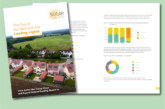
Recent research by the Solar Trade Association (STA) highlights how local authorities are taking the initiative and implementing higher building standards on developments. Jack Dobson-Smith, Public Affairs & Communications Officer at the STA, discusses the research and why government should not stymie council ambitions.
Energy use in Britain’s homes accounts for around 14% of the UK’s greenhouse gas emissions. Keeping our homes warm, well lit and functional while taking steps to decarbonise is a challenge that local authorities across the country are taking steps to tackle.
While there is much to be said about how we achieve this with the existing housing stock, many have made concerted efforts to ensure new dwellings are developed with energy efficiency and renewables in mind.
Research undertaken by the Solar Trade Association reveals that more than half of all local authorities have utilised powers granted under the Planning and Energy Act 2008 to implement higher building standards than those set by national government. One in six of these local authorities have designed policies, which go well beyond national building standards, encouraging the development of properties that have considerably smaller carbon footprints than the average home. These new dwellings will be cheaper to run owing to higher energy efficiency and the deployment of renewable energy technologies such as solar and even battery storage in some circumstances.
Milton Keynes has been singled-out as having one of the most progressive policies among local authorities. Their local plan, which was adopted in March 2019, requires developers to set out how their proposals will achieve a 19% carbon reduction improvement and provide onsite renewable energy generation, or connection to a renewable or low carbon community energy scheme, that contributes to a further 20% reduction in the residual carbon emissions. They are also one of the only local authorities to include a requirement on developers to consider ‘the opportunities to provide energy storage and demand management so as to tie in with local and national energy security priorities’.
Aiming high
Across Scotland, more than 15,000 homes a year are built to higher standards, with STA members estimating that approximately 80% of all new houses have solar PV. The likes of progressive local authorities such as Milton Keynes, Plymouth and Cambridge developing tighter Building Regulations and challenging developers to meet these more stringent requirements surely underlines the case for local authorities to retain powers to set higher standards.
Under the Government’s proposed Future Homes Standard there are plans to enforce tighter controls on carbon emissions and energy efficiency in new dwellings, but to also limit the powers that local authorities possess to set their own, more stringent standards. This risks stymieing ambitious councils at a time when the urgency to tackle climate change is substantial. Raising the policy floor is certainly welcome, but establishing a ceiling will present an unnecessary hindrance to progress.
Ultimately, many local authorities across the country have taken the initiative and are delivering robust policies, which result in energy-efficient, low-carbon homes. It is important that national government plays its role in raising standards to set the laggards on the path towards net zero, but there is little sense in blocking innovative councils that want to decarbonise faster and drive the housebuilding sector towards the inevitable — a future of energy-efficient, low-carbon homes.








